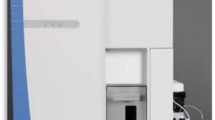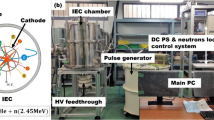Abstract
Variations in isotopic abundance provide useful information for various scientific fields. Herein we performed a feasibility study by non-destructive isotopic analysis of negative muons. We irradiated two lead plate samples, one with the natural isotopic composition and one enriched with 208Pb, with negative muons and observed the gamma rays from 208Tl with a half-life of 3 min generated via muon absorption by 208Pb during muon irradiation. The isotopic abundance of 208Pb in natPb was successfully determined without sample destruction from the gamma ray intensity to be 69%, which agreed well with the mass spectrometry results.

Similar content being viewed by others
References
Patterson C (1956) Age of meteorites and the earth. Geochim Cosmochim Acta 10:230–237. https://doi.org/10.1016/0016-7037(56)90036-9
Goucher CL, Teilhet JH, Wilson KR, Chow TJ (1976) Lead isotope studies of metal source for ancient Nigerian ‘bronzes’. Nature 262:130–131. https://doi.org/10.1038/262130a0
Ninomiya K, Kudo T, Strasser P, Terada K, Kawai Y, Tampo M, Miyake Y, Shinohara A, Kubo MK (2019) Development of non-destructive isotopic analysis methods using muon beams and their application to the analysis of lead. J Radioanal Nucl Chem 320:801–805. https://doi.org/10.1007/s10967-019-06506-9
Ponomarev LI (1973) Molecular structure effects on atomic and nuclear capture of mesons. Annu Rev Nucl Sci 23:395. https://doi.org/10.1146/annurev.ns.23.120173.002143
Measday DF (2001) The nuclear physics of muon capture. Phys Rep 354:243–409. https://doi.org/10.1016/S0370-1573(01)00012-6
Ninomiya K, Ito TU, Higemoto W, Kawamura N, Strasser P, Nagatomo T, Shimomura K, Miyake Y, Kita M, Shinohara A, Kubo MK, Miura T (2019) Negative muon capture ratios for nitrogen oxide molecules. J Radioanal Nucl Chem 319:767–773. https://doi.org/10.1007/s10967-018-6366-3
Köhler E, Bergmann R, Daniel H, Ehrhart P, Hartmann FJ (1981) Application of muonic X-ray techniques to the elemental analysis of archeological objects. Nucl Instrum Methods Phys Res 187:563–568. https://doi.org/10.1016/0029-554X(81)90389-X
Terada K, Ninomiya K, Osawa T, Tachibana S, Miyake Y, Kubo MK, Kawamura N, Higemoto W, Tsuchiyama A, Ebihara M, Uesugi M (2014) A new X-ray fluorescence spectroscopy for extraterrestrial materials using a muon beam. Sci Rep 4:5072. https://doi.org/10.1038/srep05072
Kubo K (2016) Non-destructive elemental analysis using negative muon. J Phys Soc Jpn 85:091015. https://doi.org/10.7566/JPSJ.85.091015
Ninomiya K, Kubo MK, Nagatomo T, Higemoto W, Ito TU, Kawamura N, Strasser P, Shimomura K, Miyake Y, Suzuki T, Kobayashi Y, Sakamoto S, Shinohara A, Saito T (2015) Nondestructive elemental depth-profiling analysis by muonic X-ray measurement. Anal Chem 87:4597–4600. https://doi.org/10.1021/acs.analchem.5b01169
Fricke G, Bernhardt C, Heilig K, Schaller LA, Schellenberg L, Shera EB, De Jager CW (1995) Nuclear ground state charge radii from electromagnetic interactions. Atom Data Nucl Data 60:177–285. https://doi.org/10.1006/adnd.1995.1007
Kessler D, Mes H, Thompson AC, Anderson HL, Dixit MS, Hargrove CK, McKee RJ (1975) Muonic X-rays in lead isotopes. Phys Rev C 11:1719. https://doi.org/10.1103/PhysRevC.11.1719
Budick B, Anigstein R, Kast JW (1983) Delayed gamma rays from muon capture on 207Pb. Nucl Phys A 393:469–490. https://doi.org/10.1016/0375-9474(83)90152-5
Ejiri H, Hashim IH, Hino Y, Kuno Y, Matsumoto Y, Ninomiya K, Sakamoto H, Sato A, Shima T, Shinohara A, Takahisa K, Tran NH (2013) Nuclear γ rays from stopped muon capture reactions for nuclear isotope detection. J Phys Soc Jpn 82:044202. https://doi.org/10.7566/JPSJ.82.044202
Hashim IH, Ejiri H, Shima T, Takahisa K, Sato A, Kuno Y, Ninomiya K, Kawamura N, Miyake Y (2018) Muon capture reaction on 100Mo to study the nuclear response for double-β decay and neutrinos of astrophysics origin. Phys Rev C 97:014617. https://doi.org/10.1103/PhysRevC.97.014617
Shimomura K, Koda A, Strasser P, Kawamura N, Fujimori H, Makimura S, Nakahara K, Ishida K, Nishiyama K, Miyake Y (2009) Superconducting muon channel at J-PARC. Nucl Instrum Methods A 600:192–194. https://doi.org/10.1016/j.nima.2008.11.029
Ninomiya K, Kubo MK, Strasser P, Shinohara A, Tampo M, Kawamura N, Miyake Y (2018) Isotope identification of lead by muon induced X-ray and gamma-ray measurements. JPS Conf Proc 21:011043. https://doi.org/10.7566/JPSCP.21.011043
Acknowledgements
We thank K. Hamada and S. Doiuchi (WDB EUREKA) for their kind help with the muonic X-ray measurements. The muon experiments at the Materials and Life Science Experimental facility of J-PARC were performed under a user program (Proposal Nos. 2016B0207 and 2017A0177). This research was partially supported by Japan Society for the Promotion of Science of the Grant-in-Aid for Scientific Research on Innovative Areas (18H05457, B01 team of “Toward new frontiers: Encounter and synergy of state-of-the-art astronomical detectors and exotic quantum beams”) and the Grant-in-Aid for Scientific Research (C) (18K11922).
Author information
Authors and Affiliations
Corresponding author
Additional information
Publisher's Note
Springer Nature remains neutral with regard to jurisdictional claims in published maps and institutional affiliations.
Rights and permissions
About this article
Cite this article
Kudo, T., Ninomiya, K., Strasser, P. et al. Development of a non-destructive isotopic analysis method by gamma-ray emission measurement after negative muon irradiation. J Radioanal Nucl Chem 322, 1299–1303 (2019). https://doi.org/10.1007/s10967-019-06682-8
Received:
Published:
Issue Date:
DOI: https://doi.org/10.1007/s10967-019-06682-8




